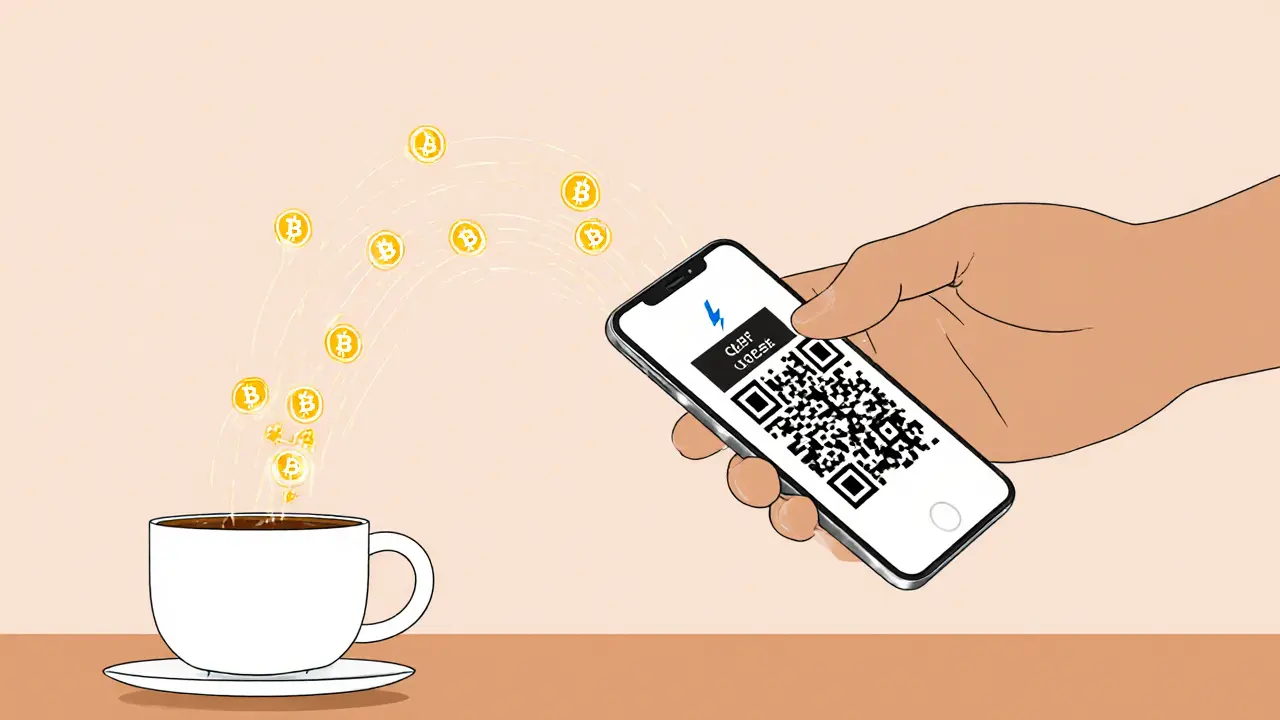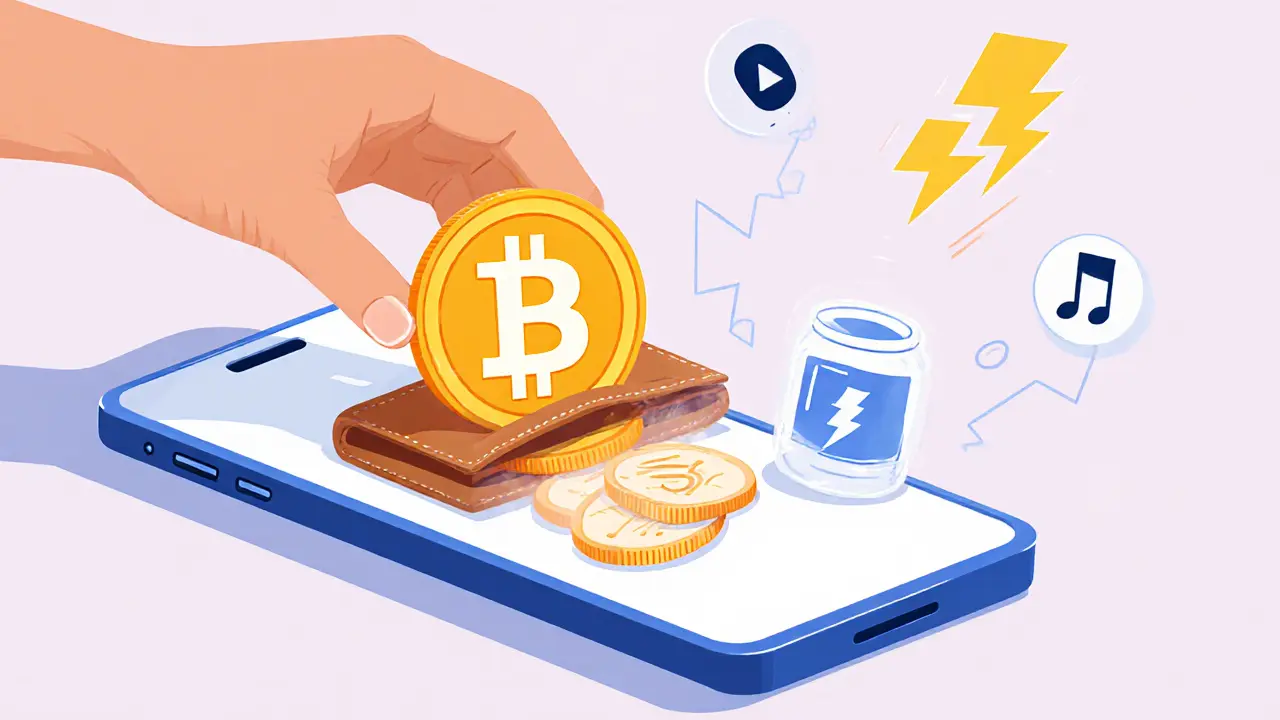Lightning Network for Instant Bitcoin Payments: How It Works and Why It Matters
 Nov, 24 2025
Nov, 24 2025
Lightning Network Transaction Cost Calculator
Note: The channel opening fee is a one-time cost for establishing a payment channel. After that, Lightning transactions are extremely cheap. This calculator assumes you're sending multiple transactions over the same channel. For single transactions, on-chain might be slightly cheaper.
Disclaimer: This calculator provides estimated costs based on current fee assumptions. Actual fees can vary depending on network congestion, wallet choices, and other factors. The Lightning Network is still evolving, so fees may change over time.
Imagine sending a Bitcoin payment faster than you can send a text message - for less than a penny. That’s what the Lightning Network makes possible. It’s not a new cryptocurrency. It’s not a fork of Bitcoin. It’s a second-layer solution built directly on top of Bitcoin that turns it from a slow, expensive digital gold into something that can actually be used for everyday purchases - coffee, snacks, online articles, even tips to creators. And it’s already working for millions of people today.
How the Lightning Network Solves Bitcoin’s Speed Problem
Bitcoin’s blockchain can only process about 7 transactions per second. Each one takes at least 10 minutes to confirm, and fees can spike to $50 during busy times. That’s fine if you’re buying a house with Bitcoin. Not so great if you’re buying a $3 burrito. The Lightning Network fixes this by moving most transactions off the main blockchain. Instead of broadcasting every single payment to everyone on the network, users open private payment channels between each other. These channels work like a shared digital ledger. Two people lock up some Bitcoin in a multi-signature address. Then they can send money back and forth between themselves, updating the balance on that ledger - no blockchain needed. Only the opening and closing of the channel get recorded on Bitcoin’s main chain. This means transactions happen in milliseconds. Fees? Often less than a cent. And because the channel is bidirectional, you can send and receive without opening a new channel every time.How Payments Flow Without Direct Connections
You don’t need a direct channel with everyone you want to pay. That’s the genius part. Let’s say you want to send 5,000 satoshis ($0.25) to your friend Alex. But you don’t have a direct channel with Alex. You do have one with Sam. And Alex has one with Sam. The Lightning Network automatically finds a path: you → Sam → Alex. Sam’s node routes the payment through, and everyone gets paid their tiny routing fee. It’s like a digital postal system where letters get forwarded through trusted hubs. This routing happens automatically, invisibly, and securely. The payment never leaves the Lightning Network until it reaches its final destination. And because each hop uses cryptographic time-locked contracts, no one can steal the funds mid-journey. If any node tries to cheat, the system penalizes them by taking their locked Bitcoin.Non-Custodial by Design
Unlike Venmo, PayPal, or even some crypto exchanges, the Lightning Network doesn’t hold your money. You control your private keys. Even when you open a payment channel, your Bitcoin stays in your wallet. The channel is just a smart contract that lets you spend it faster. This is called non-custodial. It means you never give up ownership. And if you ever need to, you can close your channel at any time - no permission needed. All your funds return to your Bitcoin wallet on-chain. This is a huge deal for privacy and control. No bank can freeze your account. No exchange can delay withdrawals. Some services like Strike or Blue Wallet make this easy by managing your channels for you (custodial wallets). But if you want full control, wallets like Muun, Breez, or Phoenix let you run your own node. You can even run a Lightning node on a Raspberry Pi at home - something thousands of people already do.
Real-World Use Cases Beyond Coffee
People aren’t just using Lightning for lunch. They’re using it for things Bitcoin couldn’t do before. - Micropayments: Pay $0.01 per article you read. No subscriptions. No ads. Sites like LightningTip and Nostr are building this already. - International remittances: Send money across borders without banks or Western Union. Fees are near zero. Settlement is instant. - Machine-to-machine payments: A smart fridge could pay for its own replacement filters. A car could pay for parking automatically. - Content creators: You can tip a YouTuber or blogger instantly with Bitcoin. Twitter’s Lightning integration lets users send tips directly in the app. - Businesses: Companies like Strike power El Salvador’s Chivo wallet. Retailers in the U.S. and Europe are starting to accept Lightning payments through APIs from providers like Voltage and Bitrefill. All of this runs on Bitcoin’s security. The Lightning Network doesn’t replace Bitcoin - it unlocks its potential as digital cash.What You Need to Get Started
You don’t need to be a tech expert to use Lightning. Here’s how to start:- Get a Bitcoin wallet: Buy some Bitcoin through a service like Simplex or Coinbase. Transfer it to a Lightning-compatible wallet.
- Choose a wallet: For beginners, try Blue Wallet, Wallet of Satoshi, or Strike. They’re simple and handle channels for you.
- Open a channel: In your wallet, select “Open Channel.” You’ll need to pay a small on-chain fee (usually under $1) to lock in your Bitcoin.
- Start paying: Scan a Lightning invoice or paste a payment request. Done.

Limitations and Challenges
It’s not perfect yet. - Liquidity issues: If you send a lot of Bitcoin out but rarely receive, your channel might run out of funds to send more. You’ll need to rebalance it, which costs a small fee. - Routing failures: Sometimes the path between you and the recipient is broken. The network tries again automatically, but occasionally payments fail. - Online requirement: To receive instant payments, your wallet or node needs to be online. If you’re offline, you can’t receive - though you can still send. - Learning curve: Non-custodial wallets require more understanding. Mistakes can cost you money. These problems are being solved. New features like trampoline routing skip middle nodes to improve success rates. Splicing lets you add or remove funds from a channel without closing it. Spontaneous payments let you send without pre-opening a channel.Where the Network Stands Today
As of late 2023, the Lightning Network handles over 5,500 BTC ($300 million) in total capacity across more than 75,000 active nodes. That’s up from just a few hundred BTC in 2019. Enterprise adoption is growing fast. Twitter, Strike, and Bitrefill are integrating Lightning. Major exchanges like Kraken and Bitfinex now offer instant Lightning deposits and withdrawals. Even small businesses in Raleigh, Austin, and Berlin are accepting Bitcoin tips via Lightning QR codes. The network’s scalability is theoretical - it could handle millions of transactions per second. That’s more than Visa. And it all runs on Bitcoin’s security, not a new blockchain.Why It’s More Than a Tech Trick
The Lightning Network isn’t just about speed. It’s about freedom. It turns Bitcoin from a speculative asset into something that can actually circulate in the real economy. People in countries with unstable currencies are using it to send money home. Creators are getting paid directly without middlemen. Small businesses are cutting payment processing fees from 3% to 0.1%. It proves Bitcoin doesn’t need to be “fixed.” It just needed a better way to move money. And that’s exactly what the Lightning Network gives us.Is the Lightning Network safe?
Yes, because it uses Bitcoin’s underlying security. All payments are backed by cryptographic smart contracts. Even off-chain transactions are enforceable on-chain if someone tries to cheat. Your funds are never at risk unless you lose your private keys or open a channel with a malicious actor - which is rare. Always use trusted wallets and avoid sending large amounts through unfamiliar routes.
Do I need to own Bitcoin to use the Lightning Network?
Yes. The Lightning Network only works with Bitcoin (BTC). You can’t use Ethereum, Litecoin, or any other cryptocurrency. You’ll need to buy Bitcoin first and deposit it into a Lightning wallet to open a payment channel. Once you have funds in the channel, you can send and receive Bitcoin instantly.
Can I use Lightning Network on my phone?
Absolutely. Mobile wallets like Blue Wallet, Wallet of Satoshi, Muun, and Phoenix make it easy. You can scan a QR code to pay or receive Bitcoin in seconds. These apps handle the technical stuff - opening channels, routing payments - so you don’t need to run a node. Just download, fund, and pay.
How much does it cost to use Lightning Network?
Opening a channel costs a Bitcoin on-chain fee - usually $0.50 to $2, depending on network congestion. Sending payments costs fractions of a cent - often less than $0.01. Receiving payments is free. Routing fees are paid by the sender, not the receiver. For most users, Lightning is the cheapest way to send Bitcoin.
What’s the difference between Lightning Network and Bitcoin on-chain?
On-chain Bitcoin transactions go directly on the main blockchain. They take 10+ minutes and cost more during busy times. Lightning transactions happen off-chain through private payment channels. They’re instant and cost pennies. On-chain is for big transfers or long-term storage. Lightning is for everyday spending. Most users do both: keep Bitcoin on-chain, use Lightning for daily payments.
Can I earn money with the Lightning Network?
Yes - if you run a node and route payments. When you help connect two users who don’t have a direct channel, you earn a tiny routing fee - often 0.000001 BTC per transaction. It’s not a get-rich-quick scheme, but thousands of operators earn $5-$50/month passively. You need a stable internet connection, technical setup, and some Bitcoin to fund channels. It’s not for everyone, but it’s a real way to earn Bitcoin without trading.